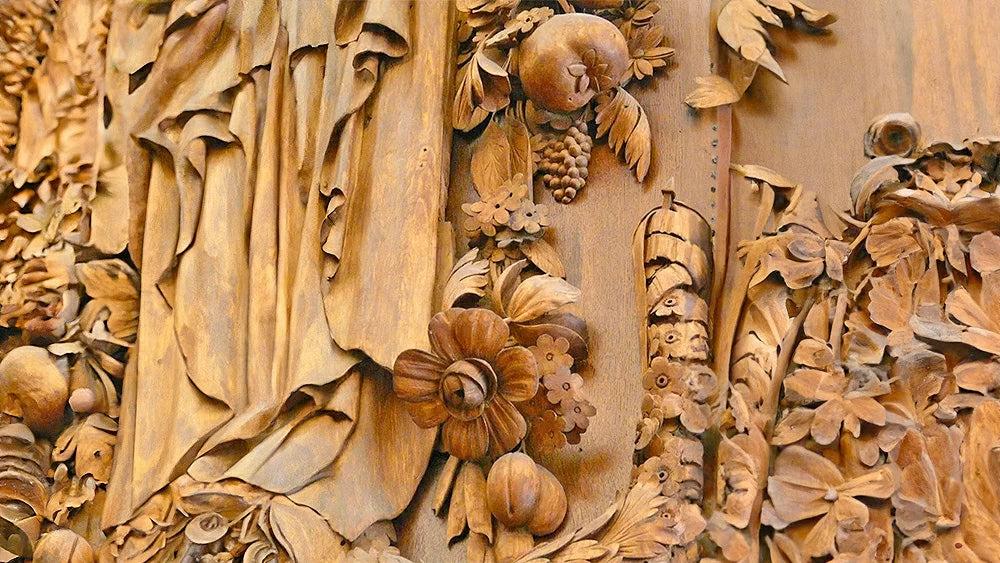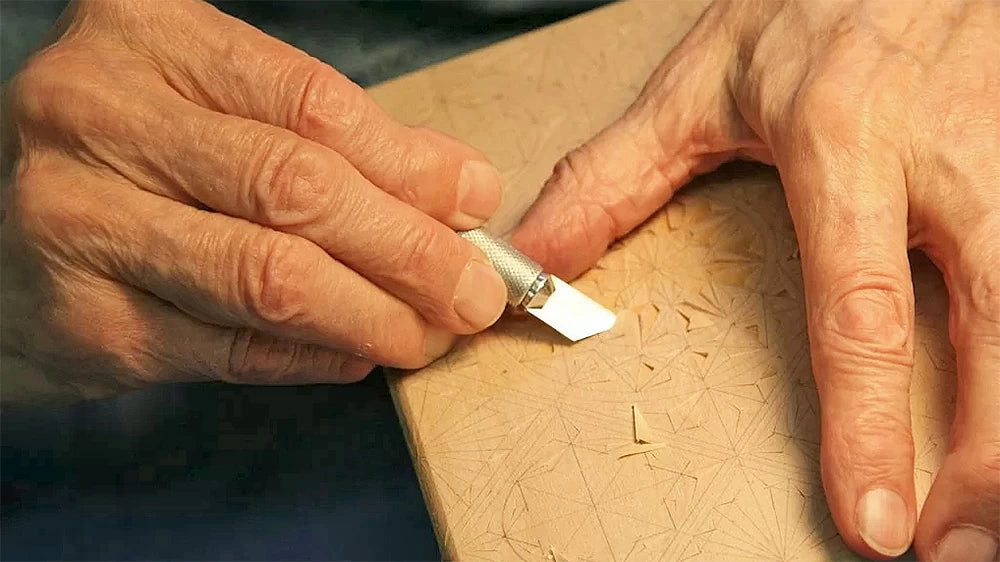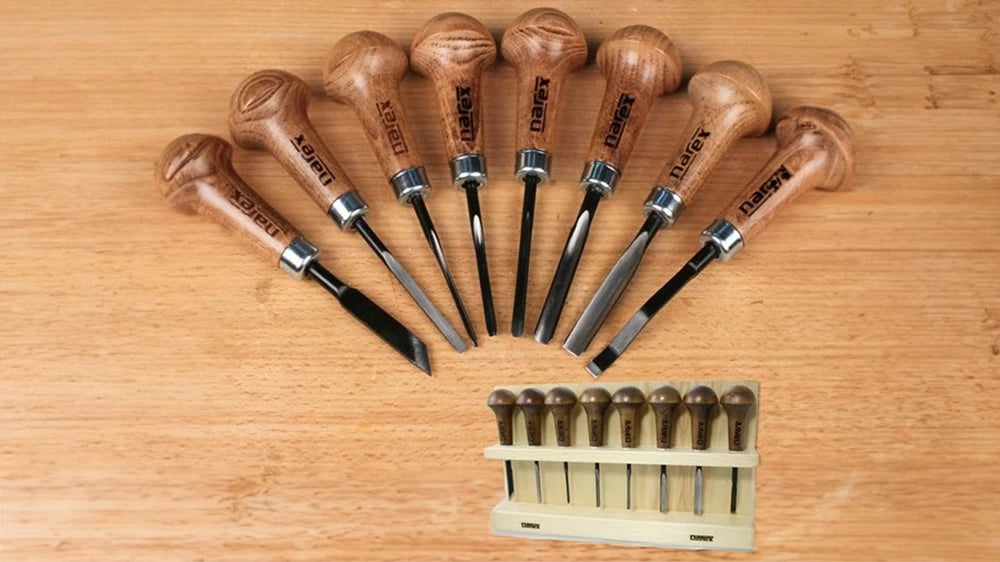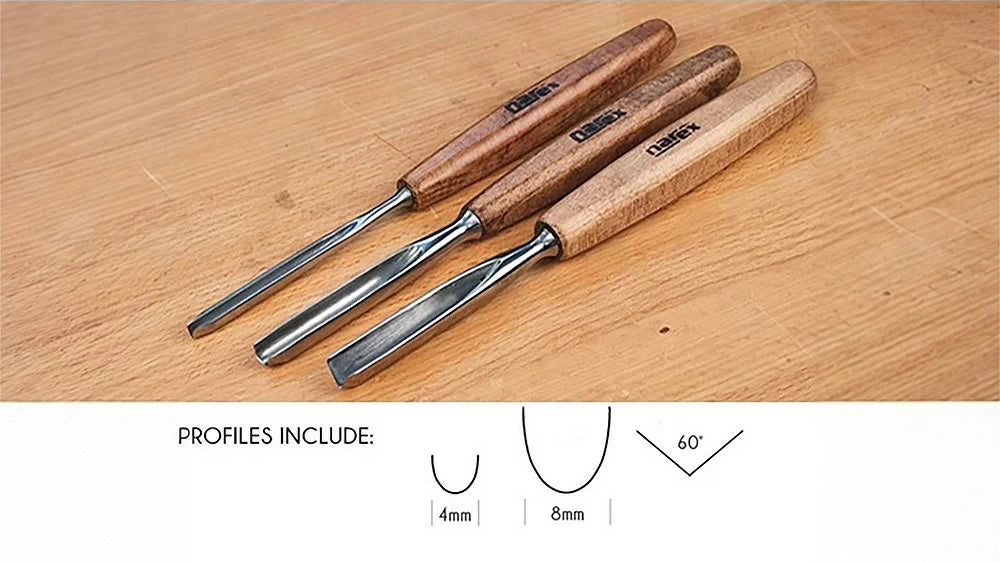Carving Tools Available from Infinity
Carving wood sounds like a simple concept, but there are multiple types of carving styles and a variety of tools to support those multiple styles, from a simple penknife, to specialized sets. This blog will give you an overview of the styles and tools and let you decide what might catch your eye!
I grew up watching my dad whittle caricature clowns and other whimsical items. He'd sit in his living room recliner with a towel across his lap and use nothing more than his pocketknife to make shavings to turn a block of wood into an eye-catching piece. His pocketknife was a little smaller than the no-name, old (but sharp) knife I carry in my pocket (photo below).

So I have always had an interest in learning to carve at some point. Several years ago, I had the opportunity to take a beginner's carving class. The instructor got me started on my first piece: The boot you see in the photo. He explained that it's the perfect project for beginners because it teaches you how to deal with changing grain direction. Once I got familiar with how to keep the carving tools sharp and make the cuts, I was hooked. Class time just flew by.
But something else interesting happened as a result of those carving classes. Knowing the basics of carving made also me a better overall woodworker. When using a carving chisel or knife, you're more aware of grain direction to avoid tearout and chipping. And having a variety of carving tools comes in handy for fine-tuning details on your project. I've even used my carving tools to create custom inlays to repair defects.
Choosing Woodcarving Tools
When it comes to woodcarving tools, my carving instructor basically said that it depends on what type of carving you intend to do. And he favored buying the tools you need when you need them rather than trying to break the piggy bank to buy them all at once. He did have a list of a few basic carving knives and palm carving tools he recommended for starters. I took his advice and added a tool here and there to my collection as I needed them.
Types of Carving
Whittling is perhaps the original form of carving. The boot I carved (shown below) is a form of whittling. It's typically done with only a sharp knife. The facets created by the knife are what give the piece its character and are usually never sanded smooth. If this is the type of carving that appeals to you, you'll certainly want to invest in a set of knives. The Narex knife set offered by Infinity Cutting Tools offers a nice selection that will get you going.

Carving "In the Round" is a more refined step up from whittling. "In the round" means you're carving in 3D, or all sides of the object. The difference being that you'll use a variety of gouges and V-tools in addition to — or instead of — carving knives. The finished surface is usually smoother and more refined than the facets left by a knife alone, such as in whittling.

Relief Carving is more of a two-dimensional carving. Relief carvings are sort of like portraits where the carving is designed to give the illusion of depth. The total depth of carving is rather shallow and only as deep as necessary to present the perception of depth and perspective. Most sign work can be considered relief carving. A shell carving on a classic Queen Anne furniture piece would be another example of relief carving.

As a side note, I'm fascinated by the work of Grinling Gibbons. He was a Dutch sculptor famous for the carvings in a lot of English churches and cathedrals in the late 1600s. His attention to detail was phenomenal and he mastered the art of illusion to give a sense of realism to his carvings.
Like carving in the round, you'll use a variety of woodcarving tools for relief carving. As a matter of fact, you'll rely more on gouges than knives in most instances.
Chip Carving is a very exacting type of carving where only knives are used to create and extract chips that create a design. Each chip is created with only two or three carefully placed and executed knife cuts. For this type of carving, you won't use gouges at all — only knives.

Types of Carving Chisels
There are several different styles of carving chisels. Carving gouges are tools with curved cutting edges designed to remove chips or shavings leaving a radiused surface or texture. The amount of curvature of the cutting edge is called "sweep." I'll talk more about that in a moment.

You'll find gouges in a number of shaft styles. Straight gouges (shown at top) are the most common and familiar. The shaft is straight from the handle down to the cutting edge.
Spoon gouges (center, above) are recognizable by their spoon shape. The shaft of the tool runs straight until the end of the tool where it curves up like the end of a spoon. Spoon gouges allow you to scoop out shavings to create unique textures. They can also be used upside down to smooth profiles on convex curves.
V-chisels, or V-gouges, (pictured at bottom) sometimes called "veiners" cut a V-shaped groove, as the name implies. They're available in a variety of sizes and angles. There are a number of other types of carving chisels that perform specialized tasks, but the types I've mentioned here are the most common.
What is "Sweep" on a Carving Chisel?
When you're shopping for carving tools, particularly gouges, you'll see a number referring to the "sweep," or curvature of the gouge. Some manufacturers differ on the exact shape and size of the curve, but in all cases, the larger the sweep number, the tighter the curve.
A No. 1 sweep is a straight chisel and may be beveled on one or both sides. A No. 2 sweep is slightly curved. The sweeps have more curvature all the way up to a No. 9, 10, or 11 or greater sweep, which is more U-shaped.
In addition to the sweep of the cutting edge, you'll also find the width of the cutting edge listed in the tool's description. Since most carving tools are made outside of the U.S.A., these width dimensions will likely be in millimeters.
V-gouges can also be grouped by their shapes, but more often, they're listed by the angle of the "V" (typically 45° and 60°) and the width of the blade from point to point.
Carving Tool Handles
You'll also notice when shopping for carving tools, a variety of handle styles. The type you choose depends mostly on the style of carving you like to do, but if you're like me, you'll end up with a variety of handle styles.
Palm tools feature a small handle that's wider at the top to nestle in the palm of the hand. These tools are designed to be pushed with the hand and not tapped with a mallet. They're used mostly for detail work.

Carving tools with traditional, full-size handles can be used with the hands but also tapped with a mallet. While full-size tools excel at removing large amounts of wood quickly when using a mallet, the long handles also offer greater control for detail work.

A compromise between palm tools and full-size tools are the medium, or mid-range, handles. Their shape mimics the larger, full-size handles but are shorter in length. They can be used by hand or with a mallet. The Narex Starter Carving Set by Infinity Cutting Tools features this handle style.

More Education
As I mentioned up front, taking a carving class was a big help for me. I highly recommend you check to see if there are local woodworking or carving clubs in your area that offer classes. Even spending a few hours with an experienced carver can be well worth the time.
Infinity Cutting Tools also offers a wide variety of books on the subject of carving. Books are great for sparking ideas for your carving, teaching some new techniques, or learning about the various types and styles of carving. Browse the library at Infinity Cutting Tools for books that are sure to help you develop your carving skills.



